Managing the Supply–Demand Mismatches and Potential Flows of Ecosystem Services in Jilin Province, China, from a Regional Integration Perspective
Abstract
1. Introduction
2. Materials and Methods
2.1. Study Area
2.2. Data Source
2.3. Research Design
2.4. ES Supply and Demand Measurement
2.4.1. Crop Production
- Supply
- 2.
- Demand
2.4.2. Carbon Storage
- Supply
- 2.
- Demand
2.4.3. Water Yield
- 1.
- Supply
- 2.
- Demand
2.4.4. Habitat Quality
- Supply
- 2.
- Demand
2.5. Analysis of ESFs and Bundles
2.5.1. Ecosystem Service Flows (ESFs)
2.5.2. ES Bundles
3. Results
3.1. Distributional Characteristics of the ES Budgets
3.1.1. Characteristics of Temporal Evolution
3.1.2. Characteristics of Spatial Evolution
3.2. Characteristics of the Spatial and Temporal Distribution of ESF Networks
3.3. Characterizing ESFs at the Cluster Scale
3.3.1. Types of ES Budget Bundles
- Bundle I: Ecological Conservation Zone
- 2.
- Bundle II: Ecological Transition Zone
- 3.
- Bundle III: Ecological Restoration Zone
- 4.
- Bundle IV: Ecologically Vulnerable Zone
3.3.2. The Interaction of ESs at the Cluster Scale
4. Discussion
4.1. Accuracy Validity of the Model
4.2. Spatial and Temporal Analysis of the ES Budgets
4.3. Integrated Management of ESs
4.4. Limitations
5. Conclusions
Author Contributions
Funding
Data Availability Statement
Conflicts of Interest
References
- Li, Y.; Liu, Z.; Li, S.; Li, X.; Wang, W. Spatiotemporal Patterning and Matching of Ecosystem Services’ Supply and Demand in Changchun, China. Land 2023, 12, 2101. [Google Scholar] [CrossRef]
- Cities in Evolution: An Introduction to the Town Planning Movement and to the Study of Civics. Geogr. J. 1916, 47, 309–311. [CrossRef][Green Version]
- Cao, Z.; Derudder, B.; Peng, Z. Comparing the physical, functional and knowledge integration of the Yangtze River Delta city-region through the lens of inter-city networks. Cities 2018, 82, 119–126. [Google Scholar] [CrossRef]
- Meijers, E. Polycentric urban regions and the quest for synergy: Is a network of cities more than the sum of the parts? Urban Stud. 2005, 42, 765–781. [Google Scholar] [CrossRef]
- Lyu, Y.; Wu, C. Managing the supply-demand mismatches and potential flows of ecosystem services from the perspective of regional integration: A case study of Hangzhou, China. Sci. Total Environ. 2023, 902, 165918. [Google Scholar] [CrossRef]
- Camagni, R.; Capello, R.; Caragliu, A. The Rise of Second-Rank Cities: What Role for Agglomeration Economies? Eur. Plan. Stud. 2015, 23, 1069–1089. [Google Scholar] [CrossRef]
- Manuel Redondo, J.; Olivar, G.; Ibarra-Vega, D.; Dyner, I. Modeling for the regional integration of electricity markets. Energy Sustain. Dev. 2018, 43, 100–113. [Google Scholar] [CrossRef]
- Kraetke, S.; Brandt, A. Knowledge Networks as a Regional Development Resource: A Network Analysis of the Interlinks between Scientific Institutions and Regional Firms in the Metropolitan region of Hanover, Germany. Eur. Plan. Stud. 2009, 17, 43–63. [Google Scholar] [CrossRef]
- Liu, J. Leveraging the metacoupling framework for sustainability science and global sustainable development. Natl. Sci. Rev. 2023, 10, nwad090. [Google Scholar] [CrossRef]
- Wang, Z.; Zhang, L.; Li, X.; Li, Y.; Frans, V.F.; Yan, J. A network perspective for mapping freshwater service flows at the watershed scale. Ecosyst. Serv. 2020, 45, 101129. [Google Scholar] [CrossRef]
- Cai, W.; Wu, T.; Jiang, W.; Peng, W.; Cai, Y. Integrating Ecosystem Services Supply-Demand and Spatial Relationships for Intercity Cooperation: A Case Study of the Yangtze River Delta. Sustainability 2020, 12, 4131. [Google Scholar] [CrossRef]
- An, Z.; Sun, C.; Hao, S. Matching relationship between supply and demand of ecosystem services from the perspective of water-energy-food nexus in Northeast China. Acta Ecol. Sin. 2024, 44, 4170–4186. [Google Scholar] [CrossRef]
- Hou, Y.; Ding, S.; Chen, W.; Li, B.; Burkhard, B.; Bicking, S.; Mueller, F. Ecosystem service potential, flow, demand and their spatial associations: A comparison of the nutrient retention service between a human- and a nature-dominated watershed. Sci. Total Environ. 2020, 748, 141341. [Google Scholar] [CrossRef] [PubMed]
- Li, K.; Hou, Y.; Andersen, P.S.; Xin, R.; Rong, Y.; Skov-Petersen, H. An ecological perspective for understanding regional integration based on ecosystem service budgets, bundles, and flows: A case study of the Jinan metropolitan area in China. J. Environ. Manag. 2022, 305, 114371. [Google Scholar] [CrossRef] [PubMed]
- Shakya, B.; Uddin, K.; Shaoliang, Y.; Bhatta, L.D.; Lodhi, M.S.; Htun, N.Z.; Yongping, Y. Mapping of the ecosystem services flow from three protected areas in the far-eastern Himalayan Landscape: An impetus to regional cooperation. Ecosyst. Serv. 2021, 47, 101222. [Google Scholar] [CrossRef]
- Wainger, L.A.; King, D.M.; Mack, R.N.; Price, E.W.; Maslin, T. Can the concept of ecosystem services be practically applied to improve natural resource management decisions? Ecol. Econ. 2010, 69, 978–987. [Google Scholar] [CrossRef]
- Burkhard, B.; Kroll, F.; Nedkov, S.; Mueller, F. Mapping ecosystem service supply, demand and budgets. Ecol. Indic. 2012, 21, 17–29. [Google Scholar] [CrossRef]
- Serna-Chavez, H.M.; Schulp, C.J.E.; van Bodegom, P.M.; Bouten, W.; Verburg, P.H.; Davidson, M.D. A quantitative framework for assessing spatial flows of ecosystem services. Ecol. Indic. 2014, 39, 24–33. [Google Scholar] [CrossRef]
- Bagstad, K.J.; Johnson, G.W.; Voigt, B.; Villa, F. Spatial dynamics of ecosystem service flows: A comprehensive approach to quantifying actual services. Ecosyst. Serv. 2013, 4, 117–125. [Google Scholar] [CrossRef]
- Schirpke, U.; Candiago, S.; Vigl, L.E.; Jager, H.; Labadini, A.; Marsoner, T.; Meisch, C.; Tasser, E.; Tappeiner, U. Integrating supply, flow and demand to enhance the understanding of interactions among multiple ecosystem services. Sci. Total Environ. 2019, 651, 928–941. [Google Scholar] [CrossRef]
- Wu, F.; Shui, W.; Ma, Y.; Wu, Y.; Guo, M.; Yang, C.; Wang, Z. Ecological function zoning of the Pearl River source area based on ecosystem service clusters. J. Hydroecol. 2024, 1–14. [Google Scholar] [CrossRef]
- Peng, L.; Deng, W.; Huang, P.; Liu, Y. Evaluation of multiple ecosystem services landscape index and identification of ecosystem services bundles in Sichuan Basin. Acta Ecol. Sin. 2021, 41, 9328–9340. [Google Scholar]
- Larondelle, N.; Lauf, S. Balancing demand and supply of multiple urban ecosystem services on different spatial scales. Ecosyst. Serv. 2016, 22, 18–31. [Google Scholar] [CrossRef]
- Kroll, F.; Mueller, F.; Haase, D.; Fohrer, N. Rural-urban gradient analysis of ecosystem services supply and demand dynamics. Land Use Policy 2012, 29, 521–535. [Google Scholar] [CrossRef]
- Palomo, I.; Martin-Lopez, B.; Potschin, M.; Haines-Young, R.; Montes, C. National Parks, buffer zones and surrounding lands: Mapping ecosystem service flows. Ecosyst. Serv. 2013, 4, 104–116. [Google Scholar] [CrossRef]
- Jager, H.I.; Nair, S.S.; Efroymson, R.A.; DeRolph, C.R.; Parish, E.S.; Wang, G. Ecosystem services from partially harvested riparian buffers can offset biomass production costs. Sci. Total Environ. 2023, 889, 164199. [Google Scholar] [CrossRef]
- Aziz, T. Accounting impacts of renewable energy expansions on ecosystem services to balance the trade-offs. Sci. Total Environ. 2023, 879, 162990. [Google Scholar] [CrossRef]
- Yao, J.; He, X.; Chen, W. The latest progress in ecosystem service flow research methods. Chin. J. Appl. Ecol. 2018, 29, 335–342. [Google Scholar] [CrossRef]
- Zank, B.; Bagstad, K.J.; Voigt, B.; Villa, F. Modeling the effects of urban expansion on natural capital stocks and ecosystem service flows: A case study in the Puget Sound, Washington, USA. Landsc. Urban Plan. 2016, 149, 31–42. [Google Scholar] [CrossRef]
- Funk, A.; Martinez-Lopez, J.; Borgwardt, F.; Trauner, D.; Bagstad, K.J.; Balbi, S.; Magrach, A.; Villa, F.; Hein, T. Identification of conservation and restoration priority areas in the Danube River based on the multi-functionality of river-floodplain systems. Sci. Total Environ. 2019, 654, 763–777. [Google Scholar] [CrossRef]
- Bagstad, K.J.; Semmens, D.J.; Ancona, Z.H.; Sherrouse, B.C. Evaluating alternative methods for biophysical and cultural ecosystem services hotspot mapping in natural resource planning. Landsc. Ecol. 2017, 32, 77–97. [Google Scholar] [CrossRef]
- Hou, Y.; Burkhard, B.; Mueller, F. Uncertainties in landscape analysis and ecosystem service assessment. J. Environ. Manag. 2013, 127, S117–S131. [Google Scholar] [CrossRef] [PubMed]
- Campagne, C.S.; Roche, P.; Gosselin, F.; Tschanz, L.; Tatoni, T. Expert-based ecosystem services capacity matrices: Dealing with scoring variability. Ecol. Indic. 2017, 79, 63–72. [Google Scholar] [CrossRef]
- Field, R.D.; Parrott, L. Multi-ecosystem services networks: A new perspective for assessing landscape connectivity and resilience. Ecol. Complex. 2017, 32, 31–41. [Google Scholar] [CrossRef]
- China Soil Map Based Harmonized World Soil Database (HWSD)(v1.1) (2009). Available online: https://poles.tpdc.ac.cn/zh-hans/ (accessed on 13 August 2024).
- Yan, F.; Wei, S.; Zhang, J.; Hu, B. Depth-to-bedrock map of China at a spatial resolution of 100 meters. Sci. Data 2020, 7, 2. [Google Scholar] [CrossRef]
- World Pop Hub. Available online: https://hub.worldpop.org/ (accessed on 13 August 2024).
- Jilin Statistical Yearbook. Available online: http://tjj.jl.gov.cn/zwgk/ (accessed on 13 August 2024).
- Jilin Water Resources Bulletin. Available online: http://slt.jl.gov.cn/zwgk/szygb/ (accessed on 13 August 2024).
- Resource and Environment Science Data Center of the Chinese Academy of Science. Available online: https://www.resdc.cn/ (accessed on 13 August 2024).
- National Earth System Science Data Center, National Science & Technology Infrastructure of China. Available online: http://www.geodata.cn (accessed on 13 August 2024).
- Panek, E.; Gozdowski, D. Analysis of relationship between cereal yield and NDVI for selected regions of Central Europe based on MODIS satellite data. Remote Sens. Appl.-Soc. Environ. 2020, 17, 100286. [Google Scholar] [CrossRef]
- Zhao, W.; He, Z.; He, J.; Zhu, L. Remote sensing estimation for winter wheat yield in Henan based on the MODIS-NDVl data. Geogr. Res. 2012, 31, 2310–2320. [Google Scholar]
- Tang, H.; Li, Z. Study on Per Capita Grain Demand Based on Chinese Reasonable Dietary Pattern. Sci. Agric. Sin. 2012, 45, 2315–2327. [Google Scholar]
- Meng, Z.; Li, G. An empirical analysis of the fluctuation of food demand trends and structural changes in China. Stat. Decis. 2021, 37, 69–72. [Google Scholar] [CrossRef]
- National Bureau of Statistics. Available online: https://www.stats.gov.cn/sj/ndsj/ (accessed on 13 August 2024).
- Huang, W.; Guo, L.; Zhang, T.; Chen, T.; Chen, L.; Li, L.; Zhang, X. The Impact of Territorial Spatial Transformation on Carbon Storage: A Case Study of Suqian, East China. Land 2024, 13, 348. [Google Scholar] [CrossRef]
- Li, L.; Song, Y.; Wei, X.; Dong, J. Exploring the impacts of urban growth on carbon storage under integrated spatial regulation: A case study of Wuhan, China. Ecol. Indic. 2020, 111, 106064. [Google Scholar] [CrossRef]
- Nelson, E.; Sander, H.; Hawthorne, P.; Conte, M.; Ennaanay, D.; Wolny, S.; Manson, S.; Polasky, S. Projecting Global Land-Use Change and Its Effect on Ecosystem Service Provision and Biodiversity with Simple Models. PLoS ONE 2010, 5, e14327. [Google Scholar] [CrossRef] [PubMed]
- Feng, L.; Lei, G. Study on Spatial-temporal Evolution Characteristics and Functional Zoning of Ecosystem Services and Trade-offs/Synergies Relationships in Northeastern China. China Land Sci. 2023, 37, 100–113. [Google Scholar]
- Chen, J.T.; Zhou, C.Y.; He, N.; Wu, Y.P. Optimal acquisition time to discriminate between breast cancer subtypes with contrast-enhanced cone-beam CT. Diagn. Interv. Imaging 2020, 101, 391–399. [Google Scholar] [CrossRef] [PubMed]
- Sharps, K.; Masante, D.; Thomas, A.; Jackson, B.; Redhead, J.; May, L.; Prosser, H.; Cosby, B.; Emmett, B.; Jones, L. Comparing strengths and weaknesses of three ecosystem services modelling tools in a diverse UK river catchment. Sci. Total Environ. 2017, 584, 118–130. [Google Scholar] [CrossRef]
- Huang, M.; Yue, W.; Feng, S.; Zhang, J. Spatial-temporal evolution of habitat quality and analysis of landscape patterns in Dabie Mountain area of west Anhui province based on InVEST model. Acta Ecol. Sin. 2020, 40, 2895–2906. [Google Scholar]
- Shang, J.; Cai, H.; Long, Y.; Zeng, J.; Chen, Y.; Zhang, X. Temporal-Spatial Distribution and Transition of Habitat Quality in PoyancLake Region Based on InVEST Model. Resour. Environ. Yangtze Basin 2021, 30, 1901–1915. [Google Scholar]
- Liu, Y.; Zhou, Y.; Du, Y. Study on the Spatio-Temporal Patterns of Habitat Quality and its TerrainGradient Effects of the Middle of the Yangtze River Economic Belt Based onInVEST Model. Resour. Environ. Yangtze Basin 2019, 28, 2429–2440. [Google Scholar]
- Yang, Y.; Li, J.; Wang, L.; Wang, Z.; Yao, C.; Wang, Y. Impact of urbanization on supply and demand of typical ecosystem services in Yangtze River Delta. J. Nat. Resour. 2022, 37, 1555–1571. [Google Scholar] [CrossRef]
- Raudsepp-Hearne, C.; Peterson, G.D.; Bennett, E.M. Ecosystem service bundles for analyzing tradeoffs in diverse landscapes. Proc. Natl. Acad. Sci. USA 2010, 107, 5242–5247. [Google Scholar] [CrossRef]
- Hamann, M.; Biggs, R.; Reyers, B. Mapping social-ecological systems: Identifying ‘green-loop’ and ‘red-loop’ dynamics based on characteristic bundles of ecosystem service use. Glob. Environ. Change-Hum. Policy Dimens. 2015, 34, 218–226. [Google Scholar] [CrossRef]
- Cao, Y.; Li, G.; Tian, Y.; Fang, X.; Li, Y.; Tan, Y. Linking ecosystem services trade-offs, bundles and hotspot identification with cropland management in the coastal Hangzhou Bay area of China. Land Use Policy 2020, 97, 104689. [Google Scholar] [CrossRef]
- Huang, J.; Xie, W. China’s Future Food Supply and Demand: Prospects and Policies. Front. Sci. Technol. Eng. Manag. 2022, 41, 17–25. [Google Scholar]
- Zeng, X.; Zhang, Z.; Wang, J.; Zhao, Y. Analysis and Prospect of China’s Food Consumption. Agric. Outlook 2021, 17, 104–114. [Google Scholar]
- Deng, G.; Yang, X.; Xu, G.; Fu, J.; Mo, L.; Yang, M.; Ling, Y.; Li, L.; Li, W.; Cai, Z. Land use change and habitat quality evolution in county level in Nanxiong Basin, northern Guangdong Province. J. Chin. Urban For. 2024, 1–11. [Google Scholar]
- Yin, D.; Yu, H.; Shi, Y.; Zhao, M.; Zhang, J.; Li, X. Matching supply and demand for ecosystem services in the Yellow River Basin, China: A perspective of the water-energy-food nexus. J. Clean. Prod. 2023, 384, 135469. [Google Scholar] [CrossRef]
- Xiang, H.; Zhang, J.; Mao, D.; Wang, Z.; Qiu, Z.; Yan, H. Identifying spatial similarities and mismatches between supply and demand of ecosystem services for sustainable Northeast China. Ecol. Indic. 2022, 134, 108501. [Google Scholar] [CrossRef]
- Zhao, Y.; Zhou, J.; Lei, L.; Xiang, J.; Huang, M.; Feng, W.; Zhu, G.; Wei, W.; Wang, j. Identification of drivers for water yield in the upstream of Shiyang River based on InVEST model. Chin. J. Ecol. 2019, 38, 3789–3799. [Google Scholar] [CrossRef]
- Liu, M.; Zhong, J.; Wang, B.; Mi, W. Spatiotemporal change and driving factor analysis of the Qinghai LakeBasin based on InVEST mode. Sci. Geogr. Sin. 2023, 43, 411–422. [Google Scholar] [CrossRef]
- Li, X.; Liu, Z.; Li, S.; Li, Y.; Wang, W. Urban Land Carbon Emission and Carbon Emission Intensity Prediction Based on Patch-Generating Land Use Simulation Model and Grid with Multiple Scenarios in Tianjin. Land 2023, 12, 2160. [Google Scholar] [CrossRef]
- Zhai, T.; Wang, J.; Jin, Z.; Qi, Y. Change and correlation analysis of the supply-demand pattern of ecosystem services in the Yangtze River Economic Belt. Acta Ecol. Sin. 2019, 39, 5414–5424. [Google Scholar]
- Zhuang, S.; Gong, J.; Chen, K.; Li, J. Supply and demand matching characteristics of cultural ecosystem services of small parks and greenbelts in the Guangdong-Hong Kong-MacaoGreater Bay Area. Acta Ecol. Sin. 2023, 43, 5714–5725. [Google Scholar]
- Wang, X.; Yao, W.; Feng, X.; Jia, Z.; Zhang, X.; Ma, J.; Zhou, j.; Tu, Y.; Sun, Z. Changes and driving factors of ecosystem services supply and demand on the Tibetan plateau. Acta Ecol. Sin. 2023, 43, 6968–6982. [Google Scholar] [CrossRef]
- Lyu, Y.; Wang, M.; Zou, Y.; Wu, C. Mapping trade-offs among urban fringe land use functions to accurately support spatial planning. Sci. Total Environ. 2022, 802, 149915. [Google Scholar] [CrossRef] [PubMed]
- Fagerholm, N.; Eilola, S.; Arki, V. Outdoor recreation and nature’s contribution to well-being in a pandemic situation-Case Turku, Finland. Urban For. Urban Green. 2021, 64, 127257. [Google Scholar] [CrossRef]
- Johnson, J.A.; Jones, S.K.; Wood, S.L.R.; Chaplin-Kramer, R.; Hawthorne, P.L.; Mulligan, M.; Pennington, D.; DeClerck, F.A. Mapping Ecosystem Services to Human Well-being: A toolkit to support integrated landscape management for the SDGs. Ecol. Appl. 2019, 29, e01985. [Google Scholar] [CrossRef]
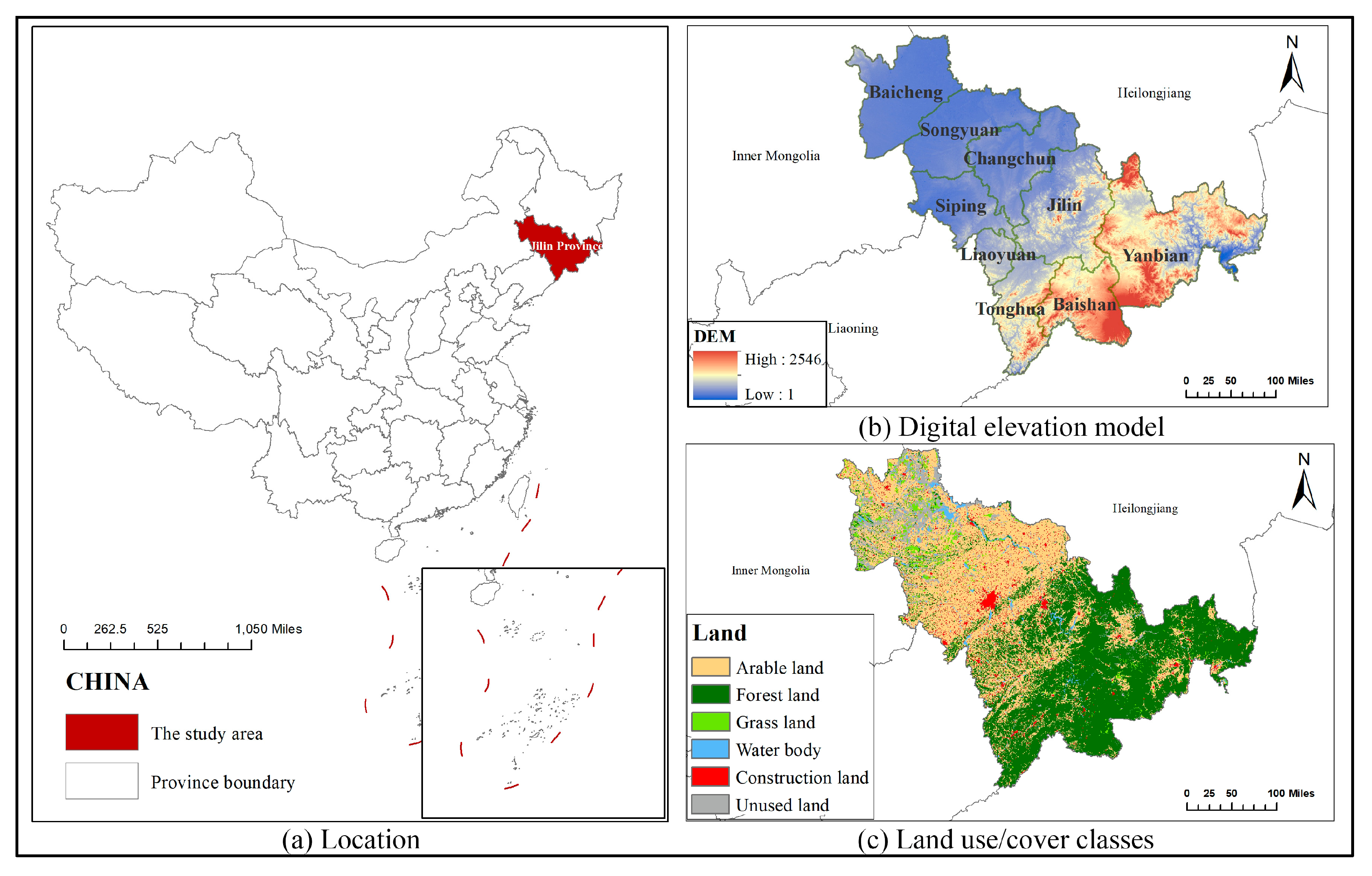
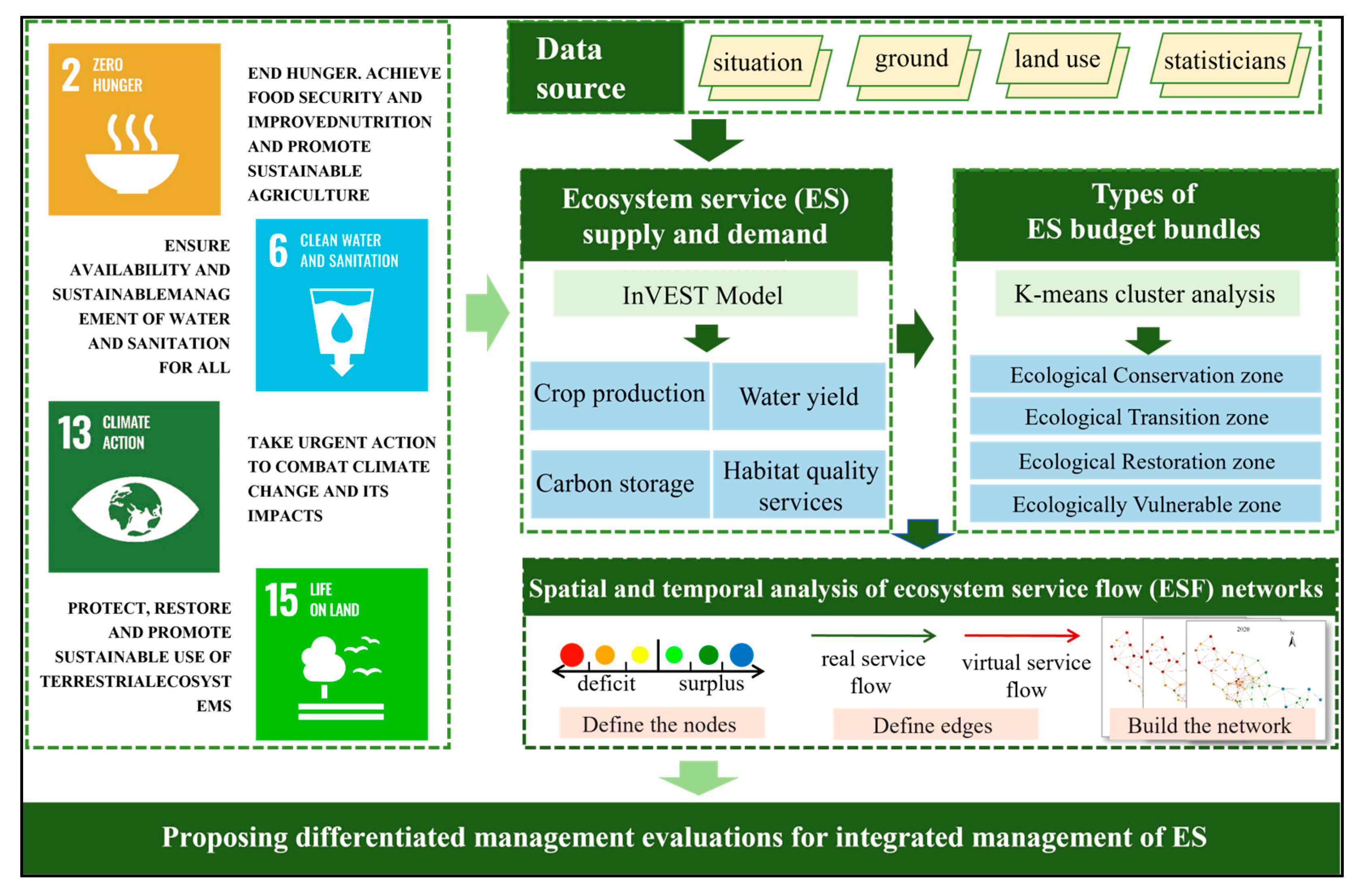

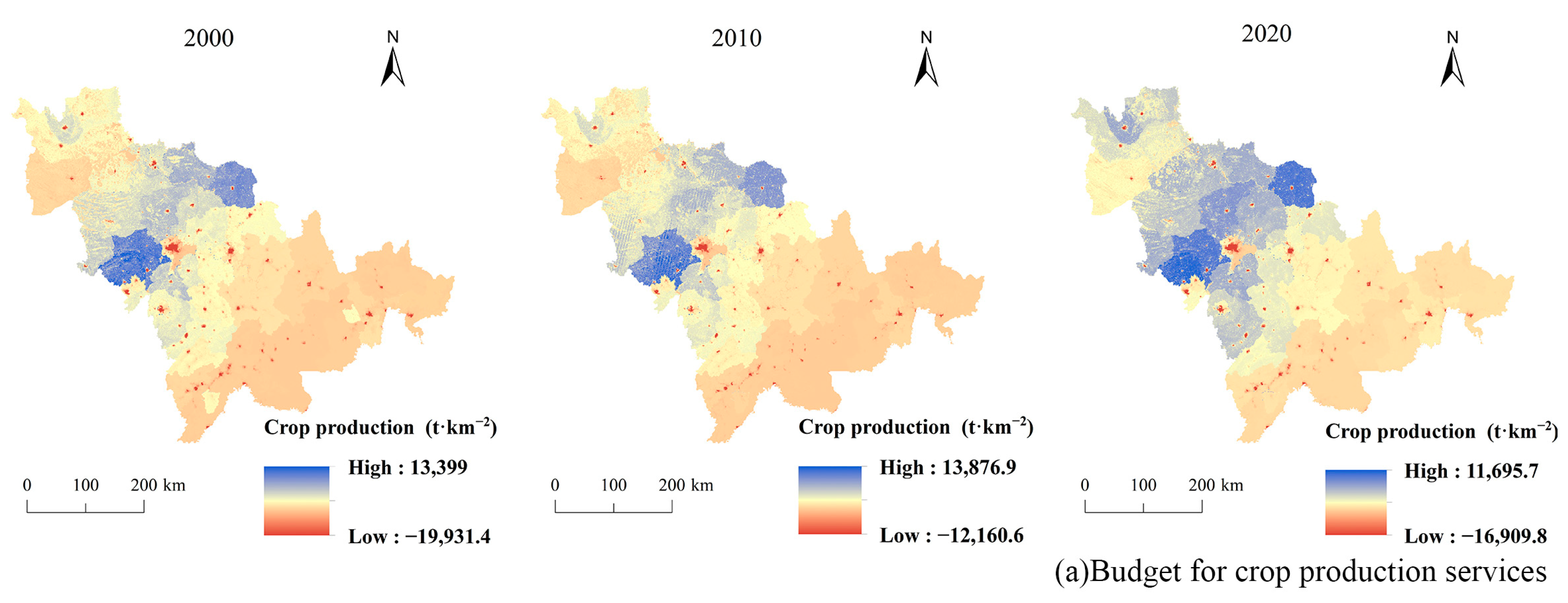
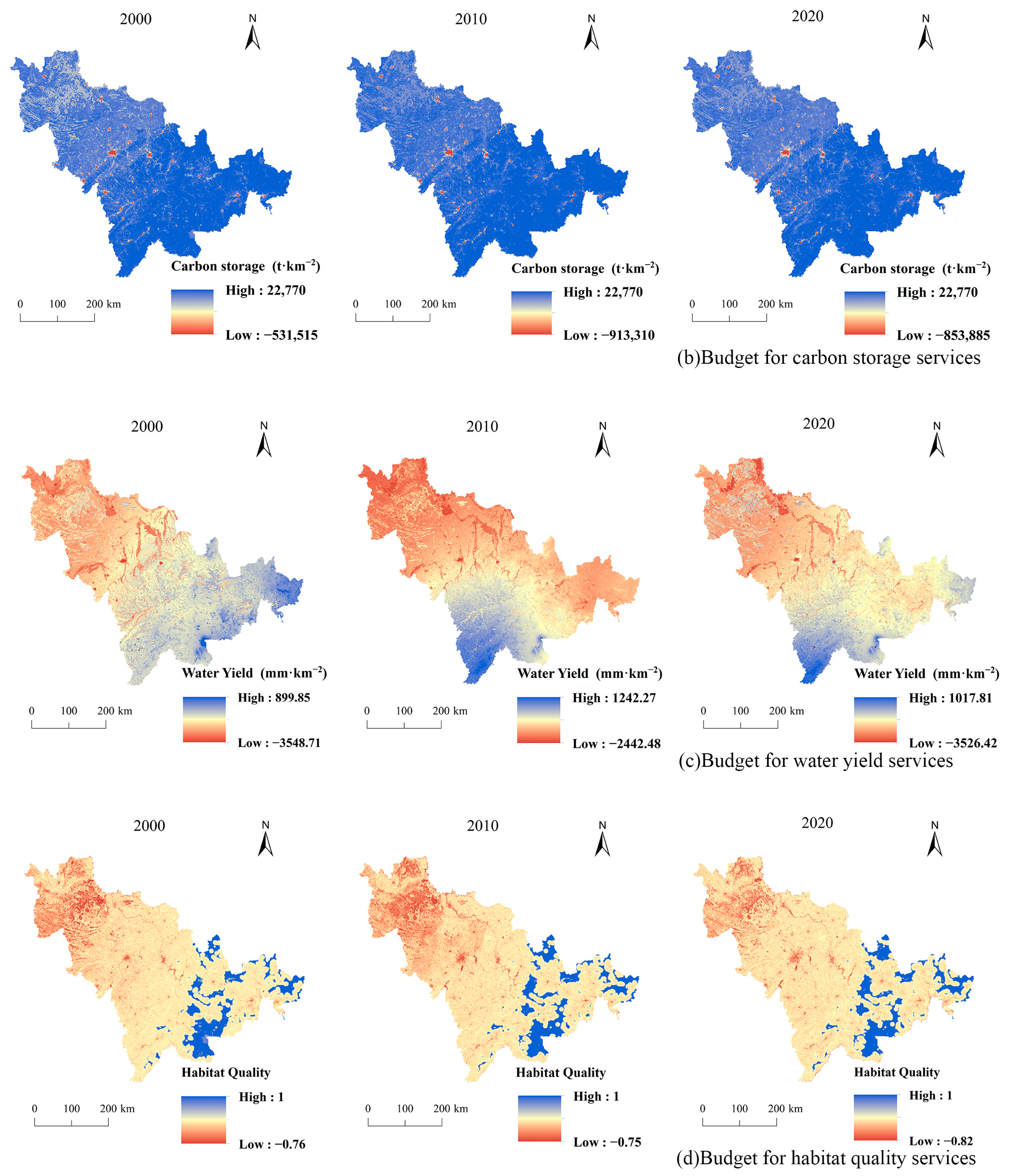
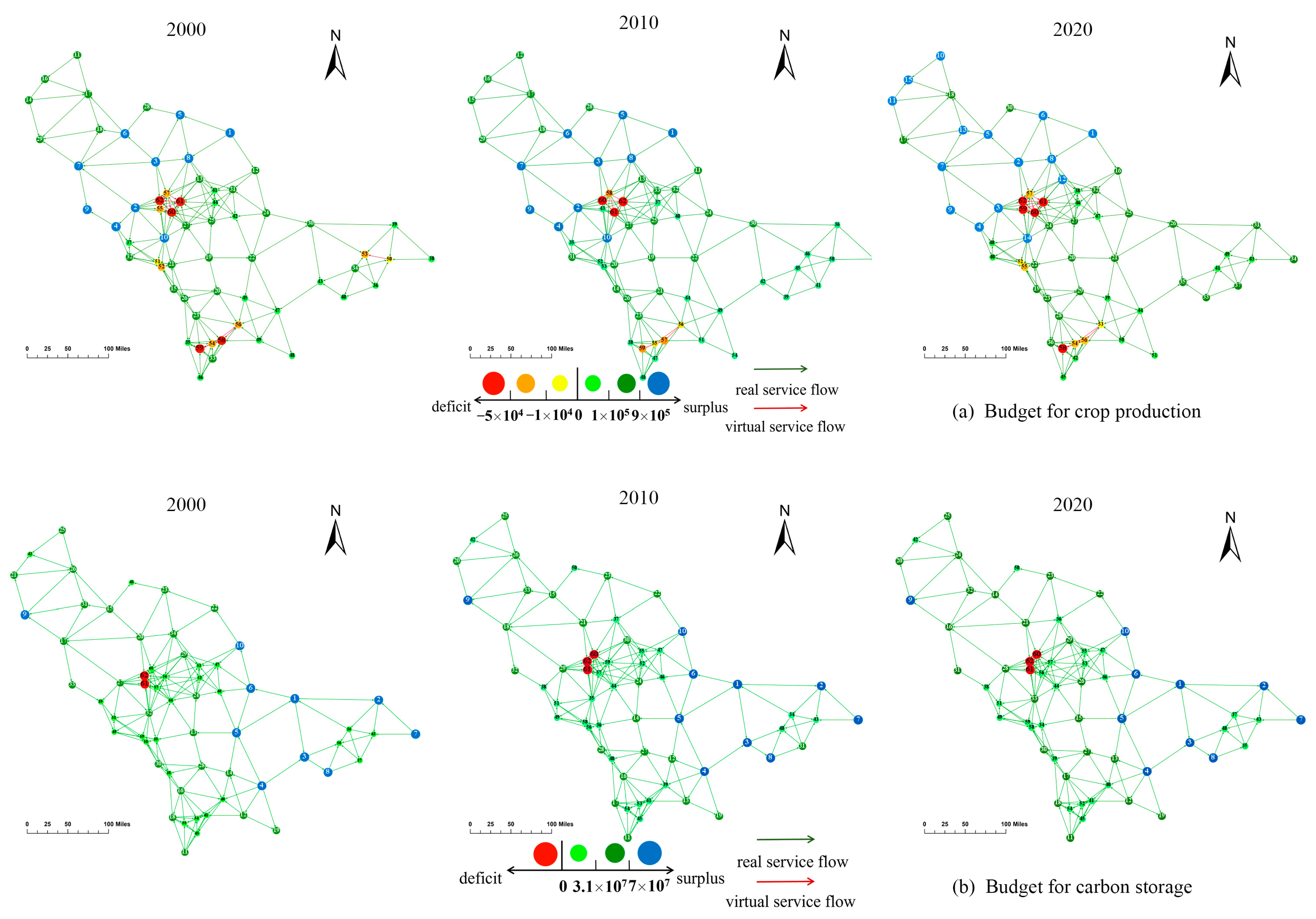
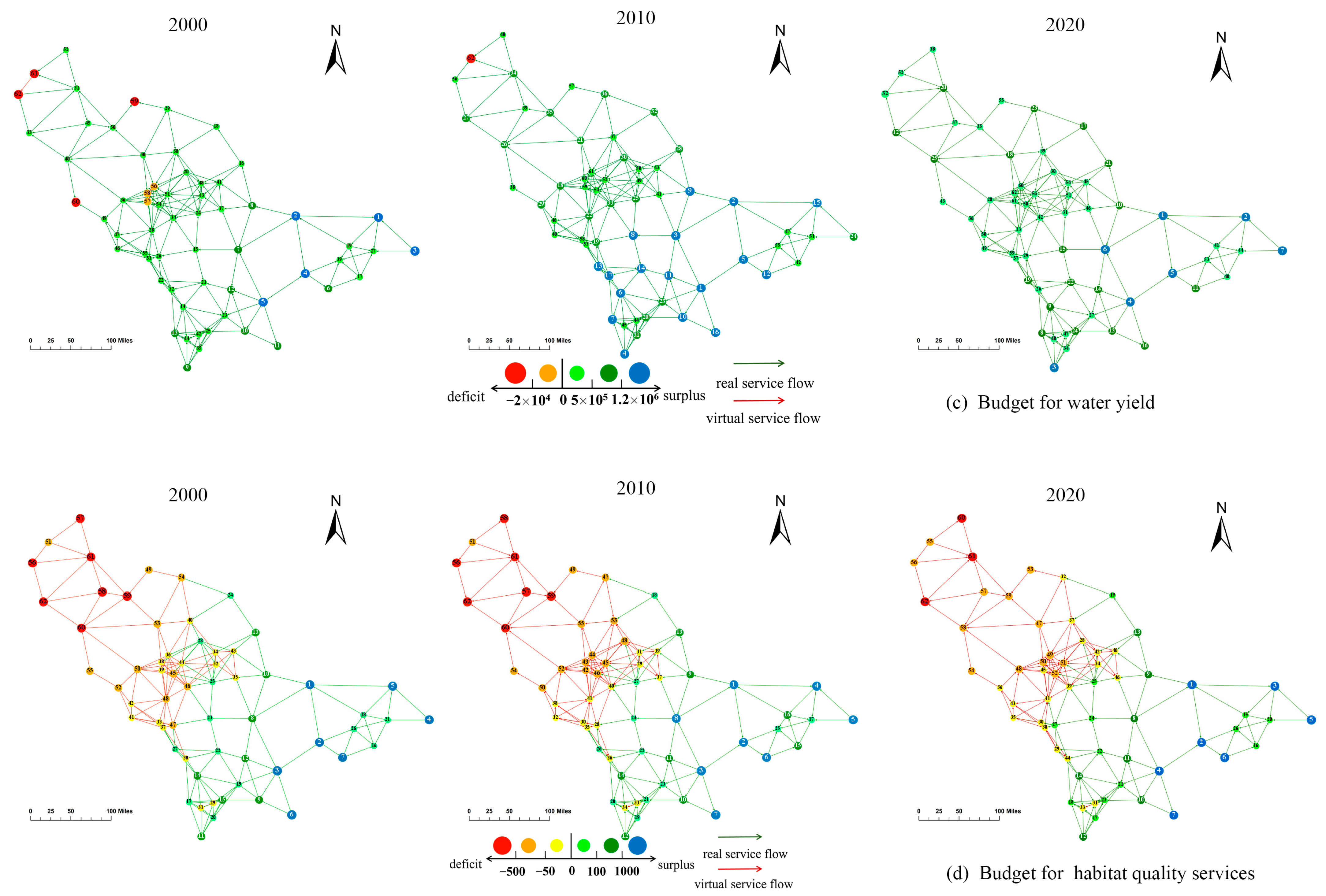

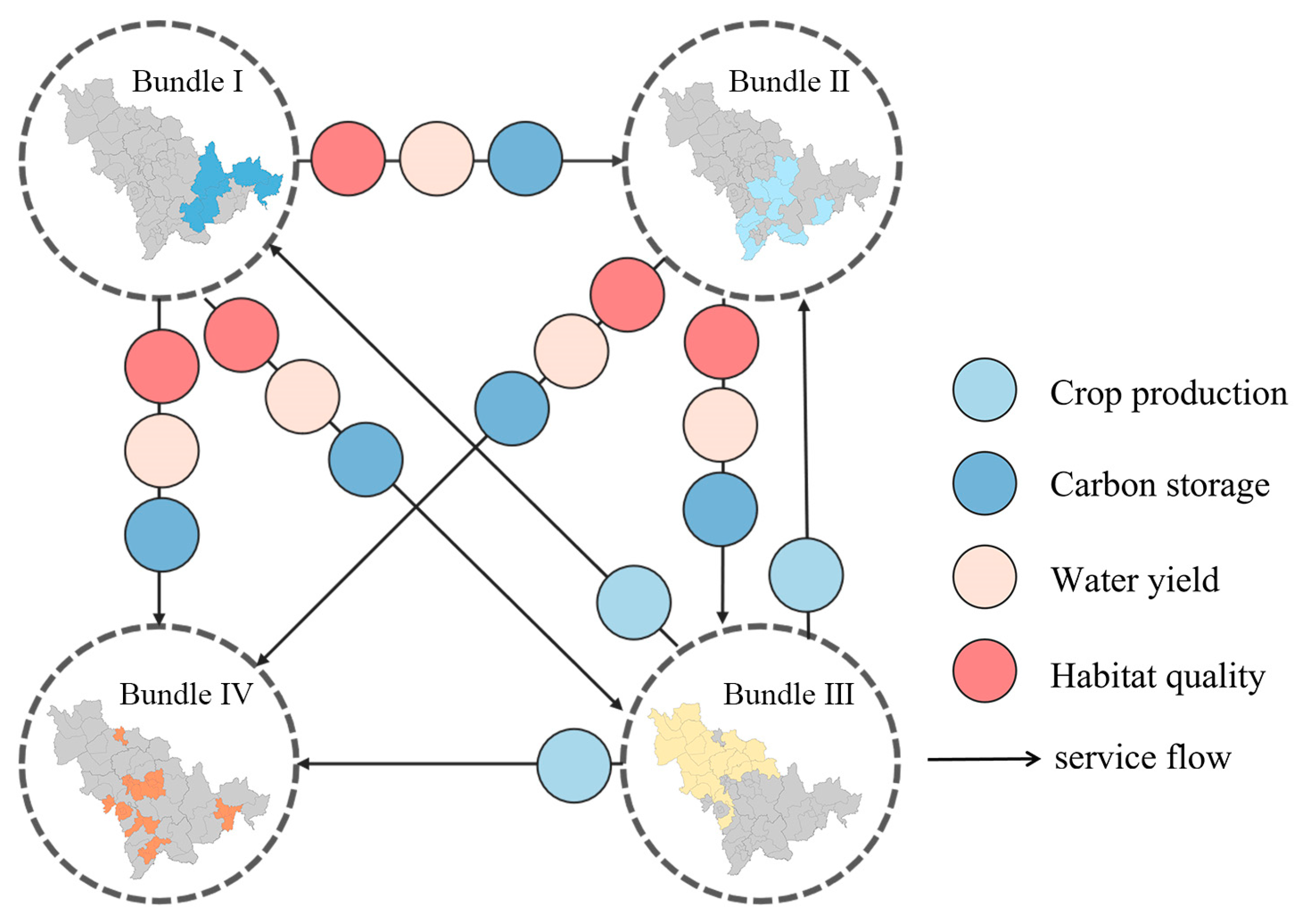
| Data Type | Year of Data | Data Format | Data Source | Application Module |
|---|---|---|---|---|
| Administrative boundaries | 2000/2010/2020 | Vector data | RESDC 1 | CP/CS/WY/HQ |
| Land use | 2000/2010/2020 | raster (30 m) | RESDC 1 | CP/CS/WY/HQ |
| Normalized difference vegetation index | 2000/2010/2020 | raster (30 m) | RESDC 1 | CP/HQ |
| Digital elevation model | - | raster (30 m) | RESDC 1 | CP/CS/WY |
| Precipitation | 2000/2010/2020 | raster (1 km) | NESSDC 2 | WY |
| Evapotranspiration | 2000/2010/2020 | raster (1 km) | NESSDC 2 | WY |
| Soil data | - | raster (30″) | China soil map-based harmonized world soil database (HWSD) (v1.1) (https://data.tpde.ae.cn/zh-hans/data), accessed on 1 April 2024 [35] | WY |
| Root depth | - | raster (1 km) | Depth-to-bedrock map of China at a spatial resolution of 100 m [36] | WY |
| Population density (pop) | 2000/2010/2020 | raster (1 km) | World Pop (https://hub.worldpop.org/), accessed on 1 April 2024 [37] | CP/CS/WY |
| Food production | 2000/2010/2020 | statistics data | Jilin Statistical Yearbook (http://tjj.jl.gov.cn/zwgk/), accessed on 8 April 2024 [38] | CP |
| Food demand | 2000/2010/2020 | statistics data | Jilin Statistical Yearbook (http://tjj.jl.gov.cn/zwgk/), accessed on 15 April 2024 [38] | CP |
| Standard coal consumption | 2000/2010/2020 | statistics data | Jilin Statistical Yearbook (http://tjj.jl.gov.cn/zwgk/), accessed on 26 April 2024 [38] | CS |
| Water demand | 2000/2010/2020 | statistics data | Jilin Water Resources Bulletin (http://slt.jl.gov.cn/zwgk/szygb/index.html), accessed on 30 April 2024 [39] | WY |
| Land Use | Cabove | Cbelow | Csoil | Cdead |
|---|---|---|---|---|
| Arable land | 2.88 | 0.54 | 104.93 | 0 |
| Forest land | 20.36 | 7.69 | 170.00 | 0 |
| Grass land | 0.28 | 1.76 | 89.02 | 0 |
| Water body | 0.18 | 0 | 63.90 | 0 |
| Construction land | 0.15 | 0 | 57.52 | 0 |
| Unused land | 0.08 | 0 | 58.78 | 0 |
| Threat Factor | Weights | Maximum Impact Distance (km) | Distance Decay Function |
|---|---|---|---|
| Arable land | 0.7 | 8 | linear |
| Urban land | 1 | 10 | exponential |
| Rural residential land | 0.6 | 5 | exponential |
| ES Types | CP (t/km2) | CS (t/km2) | ||||
|---|---|---|---|---|---|---|
| Year | Supply | Demand | Budget | Supply | Demand | Budget |
| 2000 | 153.65 | 13.30 | 175.28 | 15,486.15 | 358.39 | 15,595.49 |
| 2010 | 151.41 | 9.39 | 150.61 | 15,499.04 | 708.84 | 15,533.08 |
| 2020 | 177.46 | 11.33 | 187.10 | 15,444.02 | 575.61 | 15,608.32 |
| ES types | WY (mm/km2) | HQ | ||||
| 2000 | 184.46 | 50.93 | 131.05 | 0.12 | 0.07 | 0.05 |
| 2010 | 353.45 | 50.57 | 300.97 | 0.12 | 0.08 | 0.04 |
| 2020 | 302.33 | 49.10 | 254.14 | 0.12 | 0.05 | 0.07 |
Disclaimer/Publisher’s Note: The statements, opinions and data contained in all publications are solely those of the individual author(s) and contributor(s) and not of MDPI and/or the editor(s). MDPI and/or the editor(s) disclaim responsibility for any injury to people or property resulting from any ideas, methods, instructions or products referred to in the content. |
© 2024 by the authors. Licensee MDPI, Basel, Switzerland. This article is an open access article distributed under the terms and conditions of the Creative Commons Attribution (CC BY) license (https://creativecommons.org/licenses/by/4.0/).
Share and Cite
Jin, X.; Wang, J.; Liu, D.; Li, S.; Zhang, Y.; Wang, G. Managing the Supply–Demand Mismatches and Potential Flows of Ecosystem Services in Jilin Province, China, from a Regional Integration Perspective. Land 2024, 13, 1504. https://doi.org/10.3390/land13091504
Jin X, Wang J, Liu D, Li S, Zhang Y, Wang G. Managing the Supply–Demand Mismatches and Potential Flows of Ecosystem Services in Jilin Province, China, from a Regional Integration Perspective. Land. 2024; 13(9):1504. https://doi.org/10.3390/land13091504
Chicago/Turabian StyleJin, Xinyue, Jianguo Wang, Daping Liu, Shujie Li, Yi Zhang, and Guojian Wang. 2024. "Managing the Supply–Demand Mismatches and Potential Flows of Ecosystem Services in Jilin Province, China, from a Regional Integration Perspective" Land 13, no. 9: 1504. https://doi.org/10.3390/land13091504
APA StyleJin, X., Wang, J., Liu, D., Li, S., Zhang, Y., & Wang, G. (2024). Managing the Supply–Demand Mismatches and Potential Flows of Ecosystem Services in Jilin Province, China, from a Regional Integration Perspective. Land, 13(9), 1504. https://doi.org/10.3390/land13091504









